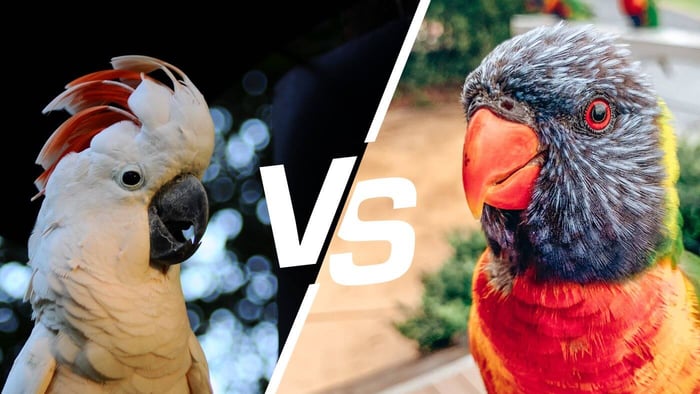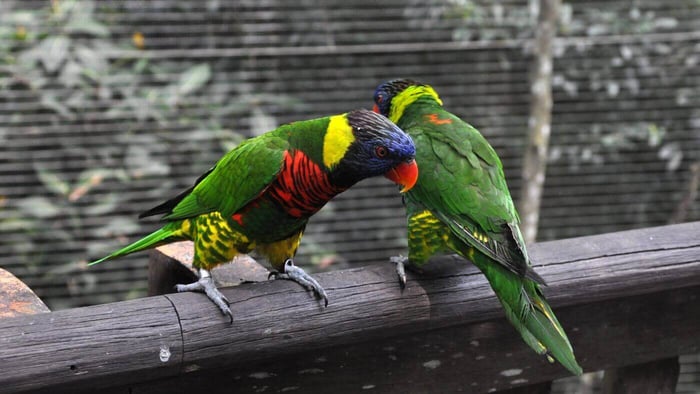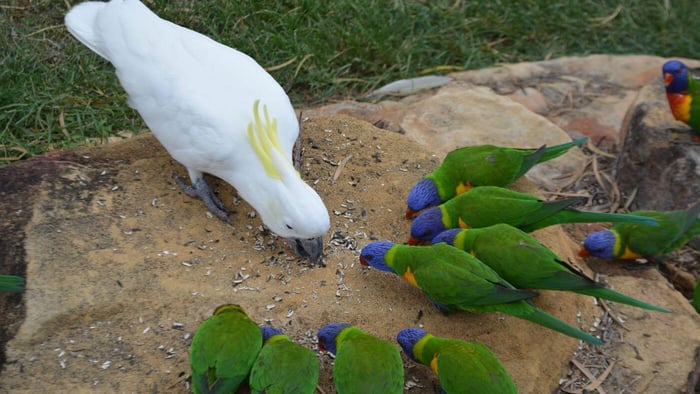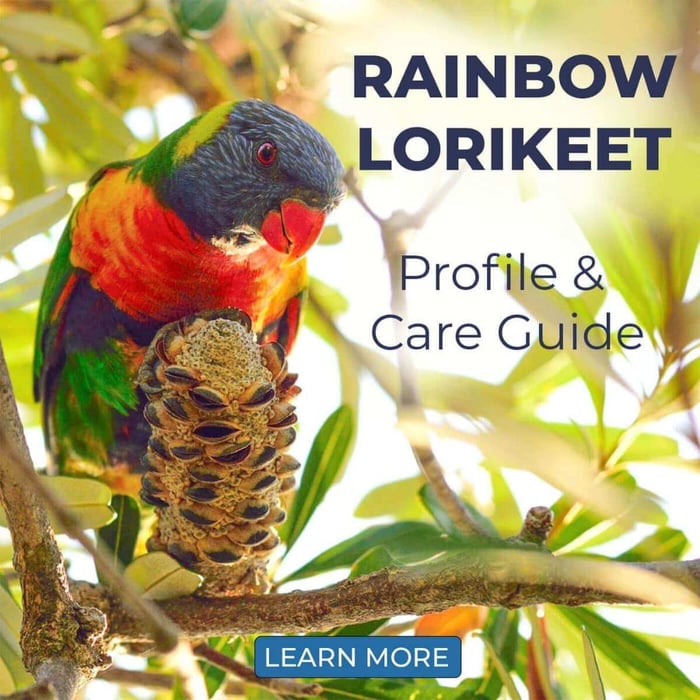What is the Difference Between Cockatoos and Lorikeets?
If you're considering bringing a parrot into your life, you may have come across these two striking options: Cockatoos and Lorikeets. Both species are captivating in their own right, but they differ greatly in terms of appearance, personality, dietary needs, and care requirements. Understanding the difference between Cockatoos and Lorikeets is crucial for making an informed decision about which bird suits your home and lifestyle.
Physical Appearance
Cockatoos are generally medium to large parrots with distinctive crests that they can raise when excited, curious or alarmed. Their plumage tends to be white, grey, black, or salmon-pink, depending on the species, and is usually more subtle compared to other parrots. Their eyes and beaks are expressive, and their head crest adds a unique charm to their overall look.
Lorikeets, on the other hand, are smaller parrots known for their vibrant rainbow colours. These birds are dazzling to behold, often displaying bright reds, greens, blues, and yellows all in one bird. Their smaller size and slender bodies make them extremely agile, and they are a joy to watch in flight.
Diet and Nutrition
Perhaps the most significant difference between Cockatoos and Lorikeets is their diet.
Cockatoos have a relatively straightforward diet consisting of high-quality pellets, seeds, nuts, fruits, and vegetables. They thrive on variety and benefit from regular changes to their meals to provide mental stimulation and balanced nutrition.
Lorikeets require a specialised diet based mainly on nectar and pollen. In captivity, this is provided through commercially prepared nectar formulas, either dry or wet. They also enjoy soft fruits such as mango, papaya, and grapes. This liquid-based diet results in watery droppings, which can be messy and may require daily cleaning of their living area.
Failing to provide the correct diet, especially for Lorikeets, can lead to serious health issues. Therefore, prospective owners must be prepared for the added responsibility of managing a more demanding feeding regimen.
Personality and Temperament
Cockatoos are among the most affectionate and social of all parrots. They thrive on interaction and form strong bonds with their human companions. Some even become overly dependent, exhibiting signs of distress or engaging in feather plucking if left alone too often. Cockatoos are intelligent, emotional birds who need daily mental and physical stimulation. They enjoy learning tricks, dancing, and being the centre of attention.
Lorikeets are best described as high-energy entertainers. They are curious, bold, and love to explore every inch of their environment. Though affectionate in their own way, they are not as cuddly as Cockatoos. They can also be quite territorial and may nip if they feel their space is being invaded. Their vocalisations are frequent and can be shrill, so they're not ideal for households that require peace and quiet.
Cleanliness and Maintenance
Both Cockatoos and Lorikeets can be messy, but in very different ways.
Cockatoos produce a fine feather dust known as dander, which can accumulate on surfaces and affect people with respiratory sensitivities. They also scatter food, chew on furniture if unsupervised, and need regular cleaning.
Lorikeets, due to their liquid-based diet, have frequent and often projectile droppings. Their cages need to be cleaned more than once a day to maintain hygiene. This can be a deal-breaker for some prospective owners, but for those who can manage it, Lorikeets are endlessly entertaining.
Housing and Space Requirements
Cockatoos require spacious cages with strong bars, as they have powerful beaks capable of damaging weak cage materials. In addition to their cage, they need plenty of out-of-cage time, climbing structures, and chewable toys to stay happy and healthy.
Lorikeets need wide enclosures that allow flight and movement, along with easy-to-clean surfaces. They benefit greatly from having branches, swings, and nectar feeders to simulate their natural environment. Lorikeets are particularly active and need ample room to express this behaviour.
Lifespan and Commitment
When choosing a parrot, lifespan is an important consideration.
Cockatoos can live for 40 to 70 years, depending on the species and quality of care. Adopting one is a lifelong commitment, often requiring succession planning should the owner become unable to care for the bird later in life.
Lorikeets have shorter lifespans, usually ranging from 15 to 20 years, though some may live longer with excellent care.
This difference between Cockatoos and Lorikeets makes Lorikeets more suitable for people who want a long-term but not lifelong commitment.
Intelligence and Training
Both Cockatoos and Lorikeets are intelligent and benefit from training.
Cockatoos are quick learners and enjoy complex challenges. They respond well to positive reinforcement and can be taught to mimic words, perform tricks, and even solve puzzles. However, their emotional intelligence means they can also develop behavioural problems if neglected or misunderstood.
Lorikeets are highly interactive and playful. They enjoy games, simple training exercises, and anything that stimulates their boundless energy. While they may not have the mimicking abilities of larger parrots, their antics and character more than make up for it.
Noise Levels
Both parrots are noisy, but the quality and intensity differ.
Cockatoos are known for their loud, piercing calls that can travel long distances. These calls are often a cry for attention or an expression of excitement.
Lorikeets have high-pitched, chattery voices. While not as loud as a Cockatoo's scream, their vocalisations are frequent and can become quite intense, especially in groups.
Which Bird is Right for You?
Choosing between a Cockatoo and a Lorikeet depends on your lifestyle, experience, and willingness to meet their specific needs. Understanding the difference between Cockatoos and Lorikeets can help you make the right choice for both you and the bird.
Choose a Cockatoo if:
- You want a deeply bonded, cuddly companion.
- You have time for daily interaction and mental stimulation.
- You are prepared for a bird with a potentially decades-long lifespan.
- You can handle loud vocalisations and some feather dust.
Choose a Lorikeet if:
- You want a colourful, energetic, and highly entertaining parrot.
- You can commit to a specialist diet and frequent cleaning.
- You enjoy playful behaviour and can provide a stimulating environment.
- You are comfortable with high-pitched noise and potential nipping.
Final Thoughts
Both Cockatoos and Lorikeets bring unique beauty and joy to any home, but they are not interchangeable. Their different care requirements, personalities, and behaviours mean it's important to match the bird to your lifestyle rather than the other way around. Understanding the difference between Cockatoos and Lorikeets is the first step in forming a happy, long-lasting bond with your parrot.
Looking for more guidance on parrot care, diet, and choosing the right species? Visit our Parrot Profiles section for expert advice and detailed parrot care guides.
FAQs
What is the main difference between Cockatoos and Lorikeets?
The key difference lies in their diet and personality—Cockatoos are affectionate and eat a variety of solid foods, while Lorikeets are energetic nectar-feeders with more demanding cleaning needs.
Do Lorikeets really need a special diet?
Yes, Lorikeets need a nectar-based diet with soft fruits and commercial nectar mixes. Feeding them a typical seed diet can cause health problems.
How noisy are Cockatiels compared to Lorikeets?
Cockatoos are very loud with piercing calls, while Lorikeets are constantly chatty and high-pitched. Neither is suited for a noise-sensitive home.
Which bird lives longer—Cockatoo or Lorikeet?
Cockatoos can live 40–70 years, making them a lifelong commitment. Lorikeets typically live 15–20 years.
How messy are Cockatoos and Lorikeets?
Cockatoos produce feather dust and can be destructive chewers. Lorikeets have frequent, watery droppings due to their liquid diet and need frequent cage cleaning.




